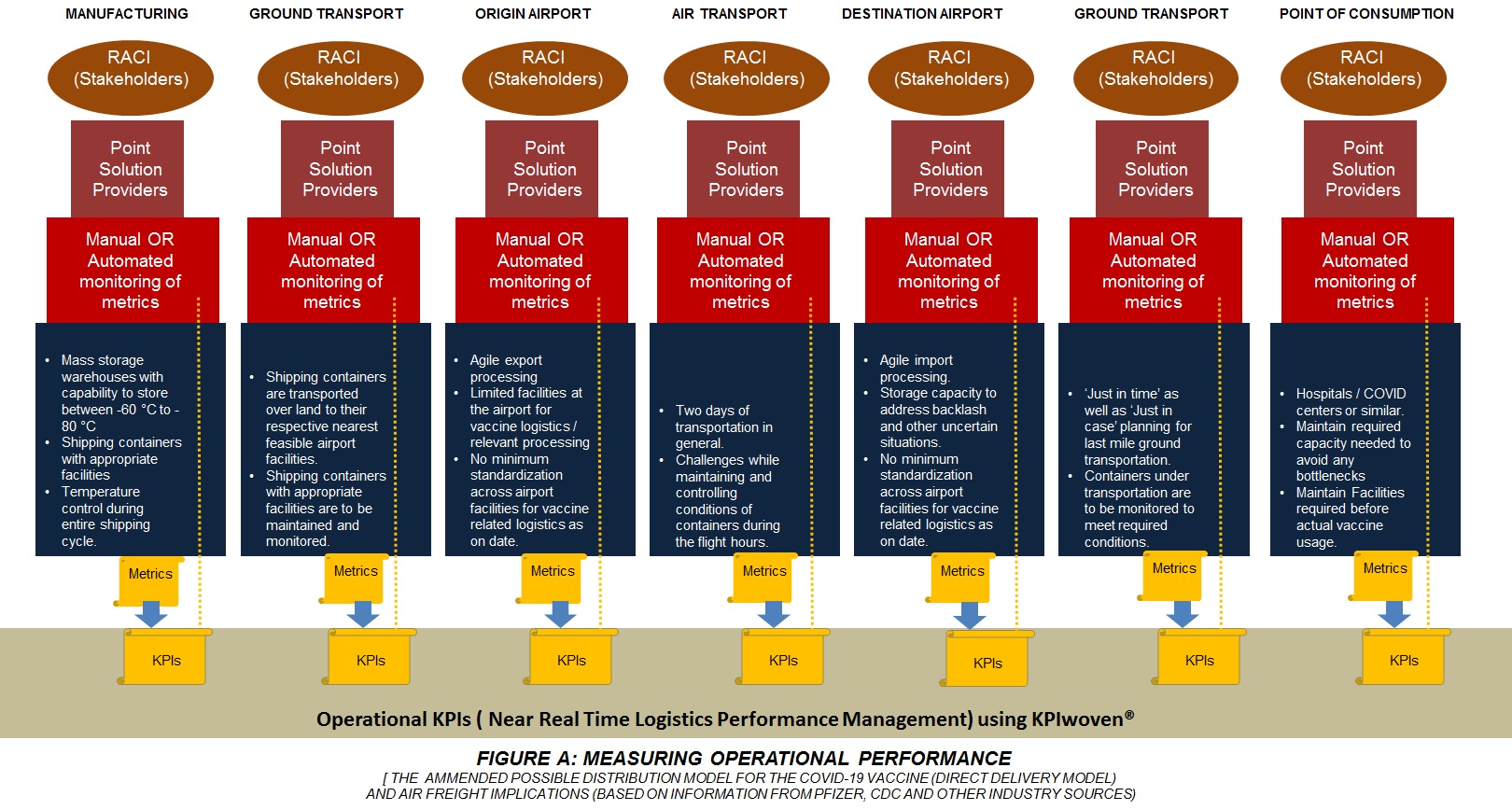
by Kedar BAGUL
Logistics Performance Management … Case of COVID-19 vaccine distribution

Logistics Performance Management … Case of COVID-19 vaccine distribution
Logistics Performance Management is not a new subject. In Sept 2020, Tiaca and Pharma.Aero conducted a survey (for the readiness of air cargo industries in transporting COVID-19 vaccine) which found that only 28% of respondents were ‘well prepared’ for the undertaking, while 19% described themselves as ‘very unprepared’.
As many of the C-level executives in logistics admit that "One of the biggest fears is that we don’t connect the dots", the real challenge lies there!
This use case describes "how the dots can be connected in a pragmatic way" and how the logistics performance can be addressed in holistic way so as to achieve optimum business performance and maximum returns using KPIwoven.
The use case makes use of ammended possible direct distribution model for the COVID-19 vaccine and freight implications based on information from Pfizer, CDC and other indusrry sources.
As depicted in FIGURE A (Measuring Operational Performance), there are 7 entities involved in direct distribution model. Every entity has got their own challenges. For the pharma companies, the major operational challenge as on today is to ensure the availability of the storage facilities that can manage the extreme temperature requirements while the vaccine is getting transported. The real-life challenge is to contribute in transporting the vaccine between 24 to 48 hours to the destination. As the aviation industry is preparing for this process, unfortunately, (as of while this article is published) there is no minimum standardization policy / SOP available for vaccine specific transportation.
CHALLENGES WHILE "CONNECTING DOTS"
The most obvious operational KPI is Turn around Time (TAT) of each entity while adhering to minimum required quality policy / SOPs. Referring to Figure A above, each of the entities would be using manual / semi-automated or full automated processes for monitoring parameters (metrics) relating to maintaining quality as per their own SOPs as well as the vaccine supplier. Metric is the smallest measurable quark in any performance management system. With traditional solutions the problem is that, the entities in upstream can know the status of the movement of the shipment but not the conditions under which the same is taken care of. Every entity will have their own solutions and ultimately, they form a huge canvas of operational silos. This is true even for the Information Management Infrastructure within every entity (the operational silos exist in majority of the aviation industries even today). Also there is no real-time visibility to KPIs related information among these entites that may be required as an "input" to their internal 'agile processing' and hence to contribute in maintaining the overall TAT.
"CONNECTING DOTS" in PRAGMATIC WAY
KPIwoven makes it possible by effectively and securely bridging these silos and hence "connecting these dots". At an operational level, relevant metrics that are measured manually or automatically can be incorporated. KPIwoven supports qualitative as well as quantitative metrics. As an example, the entity would have deployed an automated system (such as IoT) to measure temperature. KPIwoven can pull/ extract this information and map it to the relevant metrics which is quantitative metric. Any human intervented information that is ultimately mapped to the metric will relate to qualitative metric.
KPIs will be derived from logical or mathematical combinations of such metrics measured. Metrics and KPIs, measured against their expected outcomes (target values) will tell us whether actionable(s) is(are) required. KPIwoven has got in-built communication system so that all entities involved in the process can seemlessly receive relevant alerts and they can communicate with each other over agreed set of actionables and KPIs. The in-built RACI model (blended with ISO20K) makes it possible to assign action item to the responsible so that necessary action can be executed in order to improve/ optimize performance.

At a strategic level, KPIwoven provides an oppotunity to design business strategy and then map/ align operational KPIs to the business strategy, as depicted in Figure B. It also supports Strategy Cascading ....thanks to its multi-tenancy model.
The actionable can result in initiating a project and associated risk management. KPIwoven supports in managing Enterprise Risks, Operational Risks and Strategic Risks and assist in measuring their impact on business strategy while considering other operaional KPIs (cumulative impact).
Coming to the case of COVID-19 vaccine direct distribution, every entity would be measuring quite a few key metrics and deriving KPIs. Temperature, humidity values etc. would be typically measured as metric values at an operational level. Minimum temperature maintained (average hourly) during transporartion by respective entities would be a typical example of an operational KPI. All movements towards the vaccine's destination would contribute towards measuring TAT.
Entities with storage facilities, would be required to measure and monitor many metrics that are qualitative and hence addressed manually. Even on the airports, there will be quite a few qualitative metrics that are to be addressed as they will be measured on ground as part of SOP checklist. Same is applicable to "in-flight" SOP/ checklist. KPIwoven provides appropriate interface for addressing qualitative metrics.
KPIwoven provides enterprise class, secured, flexible software solution that supports Balanced Scorecards, COBIT, Blockchain, 5M and many other models thereby assist industries and organizations in optimizing their Information Management Infrastructure for operational synergy and maximum profitability. The solution is capable of interconnecting and pulling/ extracting / processing data from virtually any source / platform/ technology/ application, databases and industry sensors/ devices etc. available in today's market place.
In a nut shell, the industry should look beyond conventional business analytics tools that may not suffice while managing Enterprise Performance. Alignment of operational outcomes with business strategy is one of the critical part of the exercise in order to "connect the dots".
COVID-19 Vaccine transporartion is an opportunity for the aviation industry to connect these dots. Else this challenge is going remain as fear for mission critical applications....and a topic of discussion over business breakfast!